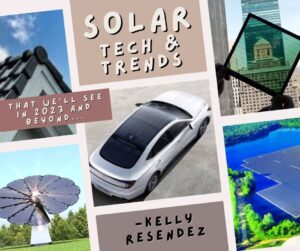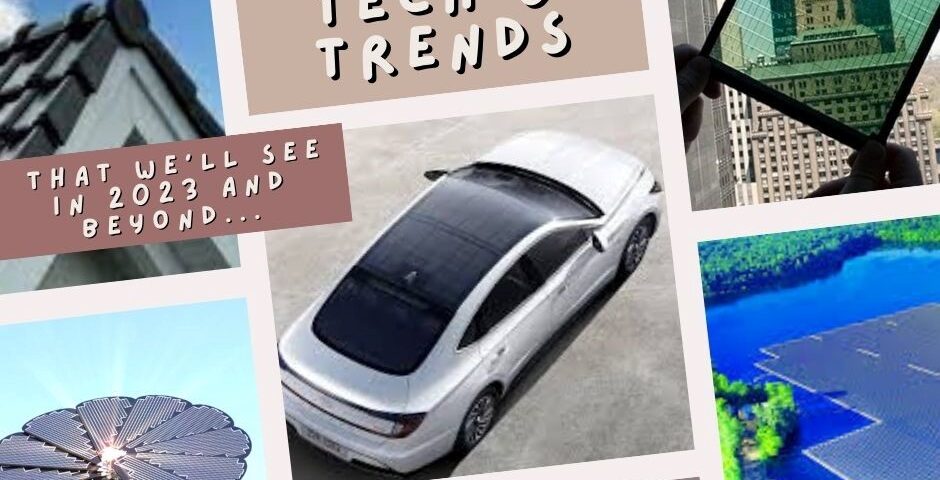
Green home improvements that increase your home’s value the most.
December 16, 2022
Green & clean energy tech and trends we’ll see in 2023 and beyond.
February 21, 2023
The shift to renewable energy sources is growing exponentially, expected to rise 80% from 2020 to 2026 alone according to McKinsey research.
Solar is the biggest contributor to that turn away from fossil fuels, including the increasing prevalence and efficiency of residential solar systems.
According to the U.S. Energy Information Administration, from 2020 to 2021 alone, solar power installations rose by 34% across the country, from 2.9 gigawatts to 3.9 gigawatts.
So, as we charge full steam into 2023, I wanted to highlight some of the innovations that we’ll see in the coming 365 days and more.
If you look back through history, most genius innovations were also profoundly simple (in retrospect), and such is the case with many of the innovations and inventions on our list.
Solar technologies and trends we’ll see in 2023 and beyond:
Solar windows
Every home, building, and office have plenty of windows. Right now, they are one of the most inefficient areas for heat loss or gain (depending on your climate and the season), driving up energy costs.
But very soon, all of those windows will actually help generate energy – not waste it – thanks to solar windows.
Constructed from solar glass that absorbs infrared and ultraviolet light, solar windows look the same as normal windows. However, they can generate 100% of needed electricity for the average home or even business. Scientists forecast that solar glass widely implemented could meet almost 40% of the total energy demand in the U.S.!
Solar windows were created eight years ago at the University of Michigan, but just recently have been perfected to the point where we will see them in everyday life soon.
Solar panels on the move
Solar panels are incredibly effective in generating energy…to a point. They also have some glaring weaknesses, such as inefficiencies during winter months, nighttime, when the weather is bad, and more. But the new, improved solar panels we’re starting to see address those weaknesses through mobility.
Movable solar panels – managed through automation and computerized analysis – follow the sun’s rays, maximizing exposure to sunlight and therefore energy generation.
Floating solar panels
One of the eureka moments in the field of solar power was to build solar farms on water, not just affixed on land. Floating solar farms are now becoming the norm, allowing them to “chase” sunlight and create energy with even greater efficiency.
They do not take up valuable land (about 70% of the earth’s surface is water, almost all of it unused), but the water can also be integrated as a natural cooling element to keep panels and equipment from overheating.
Floating solar farms are already in wide use today in Asia, with five of the largest in the world in China, Singapore, and Thailand. In fact, the world’s largest floating solar farm sits in a reservoir in Shandong, China, generating an astounding 550 million kWh of electricity per year!
Solar cars
For many decades now, we’ve envisioned the “future” where technology rules, usually featuring flying cars zipping through the air. While flying cars still seem to be five years away from being five years away, one futurized upgrade is coming sooner: solar.
In fact, a Dutch company just released a prototype and is pre-selling the Lightyear 2 SUV, the world’s first (affordable) solar car.
So far, the manufacturer has only released sketches of what their automobile will look like, but we do know that it’s a five-seat SUV that can travel about 800 kilometers (just under 500 miles) on a single electric charge.
Those charges can either come from plugging it in like a traditional e-car, or through integrated solar panels along its roof. The big selling point is not only improved efficiency thanks to those solar panels, but it will also emit about half the CO2 of other electric cars.
By 2025, the company plans on releasing a new model with larger solar cells that can fully recharge itself and has already ordered production on 21,000 models.
Photovoltaics integrated into buildings
Just as we mentioned solar glass helping convert windows into energy-generating elements, there are more opportunities to convert structures into solar assets.
Instead of just installing solar panels on rooftops, the technology has emerged to integrate Photovoltaics (PV) right into the materials that buildings are constructed from, called Building Integrated Photovoltaics (BIPV). Imagine a building where the exterior walls, windows, and entire roof are all generating solar power!
One of the most exciting of those technologies are photovoltaic shingles, or roof top tiles that each act as solar panels yet perform exactly as normal roof tiles. Companies such as Tesla, RGS Energy, SunTegra and CertainTeed are developing solar tiles further, and photovoltaic shingles now last 20-30 years or more. Most importantly, these tiles generate almost as much electricity as conventional solar panels, but at a lower overall cost.
The technology is also being perfected to use Building Integrated Photovoltaics (BIPV) through energy-generating blocks, siding, walls, and other elements that are used to construct a structure aside from its roof.
Sunlight Transport Technology
One of the inherent challenges in solar power is its stark duality – it may be hot and in-full sun on one side of a home or building, but that means the other side is in the shade. We waste a vast amount of money and resources on overcoming those inefficiencies through heat and air conditioning.
The same is true for lighting our homed – there’s always more natural light in one area while other rooms are in the dark.
But sunlight transport technology solves that problem brilliantly, illuminating entire homes, offices, or even large buildings through natural light.
Developed by Swedish firm Parans, Sunlight Transport channels sunlight from the brightest external area through fiber optic cables, spreading evenly throughout all rooms of the building. Those fiber optic cables can deliver ambient light almost 300 feet within a structure.
With this technology, energy consumption from lighting during daytime hours is almost zero. Sunlight Transport Technologylooks like any normal lamp, overhead light, or can be used creatively over large surfaces or focused as needed.
During the evening (or on cloudy/rainy days), you just flip the switch on your regular electric lighting system, but your overall energy costs are drastically reduced.
A Solar Flower
A solar flower is not an actual organic plant but a solar panel system that’s shaped like a big flower and is easily affixed to the ground.
The 12 petals open automatically each morning to collect sunlight, then closing as the sun goes down when they are no longer useful. The Solar Flower, manufactured by SmartFlower, automatically rotates to face direct sunlight as well as self-cleaning twice a day to maximize efficiency.
It’s also easy to install (just mount it and plug it in) so it’s moveable. The Solar Flower can generate about 4–6 MWh/year, which is enough to offset about half of all electricity needs for the average U.S. household.
Other cool solar “stuff”
We live in an exciting time when new technologies for Photovoltaics (PV) and clean energy are being invented and perfected right before our eyes, offering optimism that we can soon solve the world’s energy puzzle, reverse climate chaos, and also regenerate our planet.
But some of the new solar tech is just plain fun, too!
For instance, smart bike locks allow you to secure your bicycle with use of an app (no more forgetting your key or combination), which is all powered by the sun.
Solar Bluetooth speakers have been in existence for a while now, as are portable solar-powered coolers (both great for the beach!).
Solar lighting and fountains enhance your home’s aesthetic with no electricity cost.
Backpacks stitched with solar PV panels draw power from the sun and charge an internal power bank, and solar baseball hats with PVs on the brim easily plug in and charge your cell phone.
***
The future is bright for solar energy. At a point very soon, solar power will become so mainstream that we’ll only mention if something is generating energy through fossil fuels, a strange anomaly from yesteryear!



